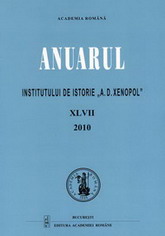Gheorghe I. Brătianu şi Franz Babinger. Convergenţe
Gheorghe I. Brătianu and Franz Babinger. Common Points
Author(s): Dan ProdanSubject(s): History
Published by: Editura Academiei Române
Keywords: historical synthesis; South-East Europe;
Summary/Abstract: 1. The historical time units scientifically and didactically analyzed by Brătianu and Babinger were identical: the universal medieval epoch with extensions to the antiquity and modern epoch (the Romanian universalist) or to the XVIIIth-XXth centuries (the German turkologist). The historical interrelationship and interconditioning between the universal and the national were very well represented in the historical concepts and contributions of the two scholars. The geographical spaces investigated by the two historians had a common factor: the Central and Eastern Europe, from the Baltic Sea to the Mediterranean and Black Seas, and the Islamic Near East. 2. Gh. I. Brătianu and Fr. Babinger, scholars of the same generation, were famous reprezentatives of the New History schools, previously germinated and individualised in Romania and Germany around the 1930s and being influenced to a certain point by the French historical current from the “Annales” and the program of the Romanian “New School” of History from 1930, Brătianu began one of the most daring and ambitious initiatives from the domain of research and studies of the universal medieval History of the inter-war period: the conceptualisation, elaboration and publishing of a new history of the European middle age, with Eastern extension: Histoire de l’Europe au Moyen Âge, 293-1566. Relying upon internal and international scientific contributions, Brătianu published his initiative/project in 1937-1939. The synthesis was divided into three volumes: I. La fin du monde antique et l’hégémonie de l’Orient (293-641); II. L’Orient et l’Occident, le Christianisme et l’Islam (641-1095); III. La formation du monde moderne et la lutte des états chrétiens contre l’Orient turc et mongol (1095-1566). However, objective and subjective causes have prevented materialization of this daring historiographical project. Brătianu drew up a monograph, posthumously published, referring to the La mer Noire. Des origines à la conquête ottomane, in which he realized a geographical and historical “radiography” of this enormous stretch of water, directly underlining its character of “revolving plate”, of transition and turning-point between Europe and Asia. The synthesis of the Romanian historian is contemporary and “a good sister” to another paradigmatical contribution in the domain, La Méditerranée et le monde méditerranéen à l’époque de Philippe II (1949), written by Fernand Braudel. Having as basis a very well drawn up and articulated research program and also didactical activities in turkology, Franz Babinger elaborated during the inter-war period over 250 turkologycal scientific papers referring to the South-East Europe and the Islamic Near East between the XIVth-XXth centuries. Babinger’s turkologycal papers had different quantitative aspects, from the two pages book review to the 500 pages historical synthesis. The same as Gh. I. Brătianu, Babinger had the gift of historical synthesis.
Journal: Anuarul Institutului de Istorie »A.D. Xenopol« - Iaşi
- Issue Year: XLVII/2010
- Issue No: 47
- Page Range: 81-96
- Page Count: 15
- Language: Romanian

